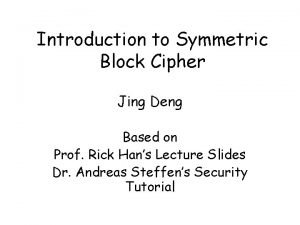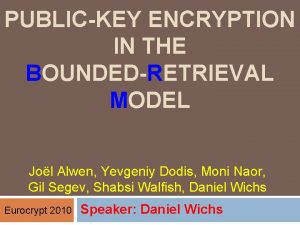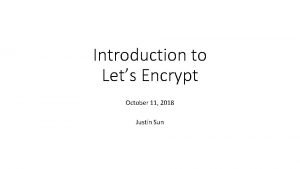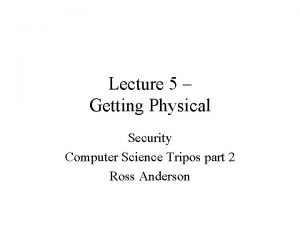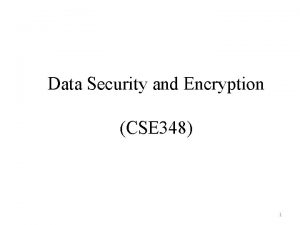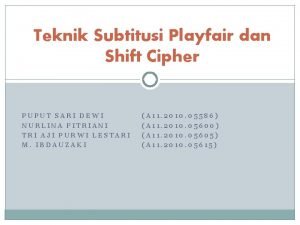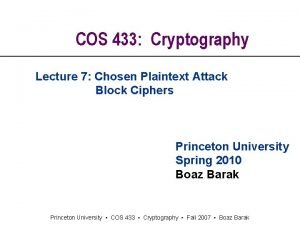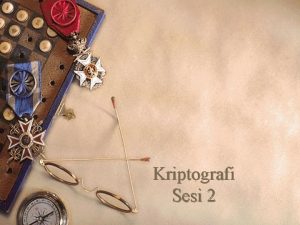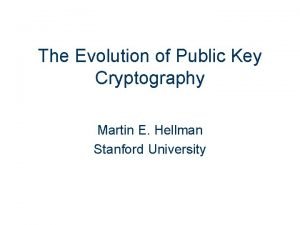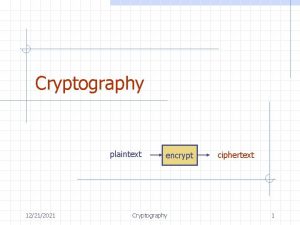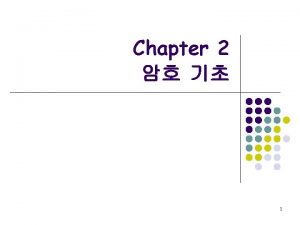Cryptography plaintext 1032020 encrypt Cryptography ciphertext 1 Outline










- Slides: 10

Cryptography plaintext 10/3/2020 encrypt Cryptography ciphertext 1

Outline Traditional cryptography Statistical attacks Secret-key encryption Public-key encryption 10/3/2020 Cryptography 2

Encryption Scenario: n n Alice wants to send a message (plaintext p) to Bob. The communication channel is insecure and can be eavesdropped If Alice and Bob have previously agreed on an encryption scheme (cipher), the message can be sent encrypted (ciphertext c) Issues: n n What is a good encryption scheme? What is the complexity of encrypting/decrypting? What is the size of the ciphertext, relative to the plaintext? If Alice and Bob have never interacted before, how can they agree on an encryption scheme? plaintext 10/3/2020 encrypt ciphertext Cryptography decrypt plaintext 3

Traditional Cryptography Ciphers were already studied in ancient times Caesar’s cipher: n n replace a with d replace b with e. . . replace z with c Caesar’s cipher is an example of a monoalphabetic substitution cipher, which permutes the characters Armed with simple statistical knowledge, one can easily break a monoalphabetic substitution cipher n n n most frequent letters in English: e, t, o, a, n, i, . . . most frequent digrams: th, in, er, re, an, . . . most frequent trigrams: the, ing, and, ion, . . . The first description of the frequency analysis attack appears in a book written in the 9 th century by the Arab philosopher al-Kindi 10/3/2020 Cryptography 4

Statistical Attacks Armed with statistical knowledge about the plaintext language, one can easily break a monoalphabetic substitution cipher n n n Most frequent characters in English: e, t, o, a, n, i, . . . Most frequent digrams: th, in, er, re, an, . . . Most frequent trigrams: the, ing, and, ion, . . . The first description of the frequency analysis attack appears in a book written in the 9 th century by the Arab philosopher al-Kindi Example (S. Singh, The Code Book, 1999): PCQ VMJYPD LBYK LYSO KBXBJXWXV BXV ZCJPO EYPD KBXBJYUXJ LBJOO KCPK. CP LBO LBCMKXPV IYJKL PYDBL, QBOP KBO BXV OPVOV LBO LXRO CI SX'XJMI, KBO JCKO XPV EYKKOV LBO DJCMPV ZOICJO BYS, KXUYPD: “DJOXL EYPD, ICJ X LBCMKXPV CPO PYDBLK Y BXNO ZOOP JOACMPLYPD LC UCM LBO IXZROK CI FXKL XDOK XPV LBO RODOPVK CI XPAYOPL EYPDK. SXU Y SXEO KC ZCRV XK LC AJXNO X IXNCMJ CI UCMJ SXGOKLU? ” OFYRCDMO, LXROK IJCS LBO LBCMKXPV CPO PYDBLK 10/3/2020 Cryptography 5

Frequency Analysis (1) We identify the most common characters, digrams and trigrams in the ciphertext Example PCQ VMJYPD LBYK LYSO KBXBJXWXV BXV ZCJPO EYPD KBXBJYUXJ LBJOO KCPK. CP LBO LBCMKXPV IYJKL PYDBL, QBOP KBO BXV OPVOV LBO LXRO CI SX'XJMI, KBO JCKO XPV EYKKOV LBO DJCMPV ZOICJO BYS, KXUYPD: “DJOXL EYPD, ICJ X LBCMKXPV CPO PYDBLK Y BXNO ZOOP JOACMPLYPD LC UCM LBO IXZROK CI FXKL XDOK XPV LBO RODOPVK CI XPAYOPL EYPDK. SXU Y SXEO KC ZCRV XK LC AJXNO X IXNCMJ CI UCMJ SXGOKLU? ” OFYRCDMO, LXROK IJCS LBO LBCMKXPV CPO PYDBLK First guess: n LBO is THE 10/3/2020 Cryptography 6

Frequency Analysis (2) Assuming LBO represents THE, we replace L with T, B with H, and O with E and get PCQ VMJYPD THYK TYSE KHXHJXWXV HXV ZCJPE EYPD KHXHJYUXJ THJEE KCPK. CP THE THCMKXPV IYJKT PYDHT, QHEP KHO HXV EPVEV THE LXRE CI SX'XJMI, KHE JCKE XPV EYKKEV THE DJCMPV ZEICJE HYS, KXUYPD: “DJEXT EYPD, ICJ X THCMKXPV CPE PYDHTK Y HXNE ZEEP JEACMPTYPD TC UCM THE IXZREK CI FXKT XDEK XPV THE REDEPVK CI XPAYEPT EYPDK. SXU Y SXEE KC ZCRV XK TC AJXNE X IXNCMJ CI UCMJ SXGEKTU? ” EFYRCDME, TXREK IJCS THE THCMKXPV CPE PYDBTK 10/3/2020 Cryptography 7

Decryption Code: X Z A V O I D B Y G E R S P C F H J K L M N Q T U W A B C D E F G H I J K L M N O P Q R S T U V W X Y Z Ciphertext: PCQ VMJYPD LBYK LYSO KBXBJXWXV BXV ZCJPO EYPD KBXBJYUXJ LBJOO KCPK. CP LBO LBCMKXPV IYJKL PYDBL, QBOP KBO BXV OPVOV LBO LXRO CI SX'XJMI, KBO JCKO XPV EYKKOV LBO DJCMPV ZOICJO BYS, KXUYPD: “DJOXL EYPD, ICJ X LBCMKXPV CPO PYDBLK Y BXNO ZOOP JOACMPLYPD LC UCM LBO IXZROK CI FXKL XDOK XPV LBO RODOPVK CI XPAYOPL EYPDK. SXU Y SXEO KC ZCRV XK LC AJXNO X IXNCMJ CI UCMJ SXGOKLU? ” OFYRCDMO, LXROK IJCS LBO LBCMKXPV CPO PYDBLK Plaintext: Now during this time Shahrazad had borne King Shahriyar three sons. On the thousand first night, when she had ended the tale of Ma'aruf, she rose and kissed the ground before him, saying: “Great King, for a thousand one nights I have been recounting to you the fables of past ages and the legends of ancient kings. May I make so bold as to crave a favour of your majesty? ” Epilogue, Tales from the Thousand One Nights 10/3/2020 Cryptography 8

Secret-Key Encryption A secret-key cipher uses a unique key K to encrypt and decrypt Caesar’s generalized cipher uses the modular addition of each character (viewed as an integer) with the key: C[i] = P[i] + K mod m P[i] = C[i] - K mod m More secure secret-key encryption schemes have been devised in this century Examples: n n DES 3 DES IDEA BLOWFISH With private-key encryption, a distinct secret key must be established for every pair of parties 10/3/2020 Cryptography 9

Public-Key Encryption Bob uses a pair of keys (KE, KD) and n n makes key KE public keeps key KD private Anyone can use the public key KE to encrypt a plaintext into a ciphertext sent to Bob Only Bob can decrypt the ciphertext using the private key KD The most popular encryption scheme is RSA, named after its inventors Rivest, Shamir, and Adleman (1978) The RSA patent expired in 2000 public key plaintext 10/3/2020 encrypt private key ciphertext Cryptography decrypt plaintext 10
